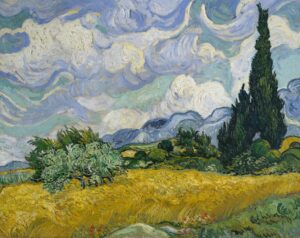Last call for ‘Van Gogh’s Cypresses’Â


Can”™t get there or missed it while you were there? Here”™s a link to the virtual tour.
And, of course, there”™s always the accompanying catalog. Though there”™s nothing quite like standing in front of a Vincent painting, with its swirling impasto ”“ and this show contains some of his most iconic works, including The Met”™s “Wheat Field With Cypresses,” which can never be loaned, as well as The Museum of Modern Art”™s “The Starry Night” ”“ the beautifully reproduced catalog contains a wealth of information not in the show. Also on the Van Gogh catalog front, Thames and Hudson will publish “Van Gogh in Auvers-Sur-Oise: His Final Months” (September, $60, 252 pages). Surveying the 74 paintings and more than 30 drawings produced by Van Gogh in the last 70 days of his life, this vibrant book is the catalog for an exhibit now at the Van Gogh Museum in Amsterdam that travels to the Musée d”™Orsay in Paris in October.

While you”™re at The Met, check out two exhibits that are, each in its own way, about cultural appropriation. British-born New Yorker Cecily Brown reinterprets the art historical canon in “Cecily Brown: Death and the Maid” (through Dec. 3), using an abstract style that demonstrates a felicity for color and composition. Meanwhile, Buddhism”™s ability to reclaim the nature deities of ancient India is plumbed in “Tree & Serpent: ”¯Early Buddhist Art in India, 400 B.C.E.-200 C.E.” (through Nov. 13). This is serenely sensual show of lush vegetation ”“ and even lusher gods and goddesses.